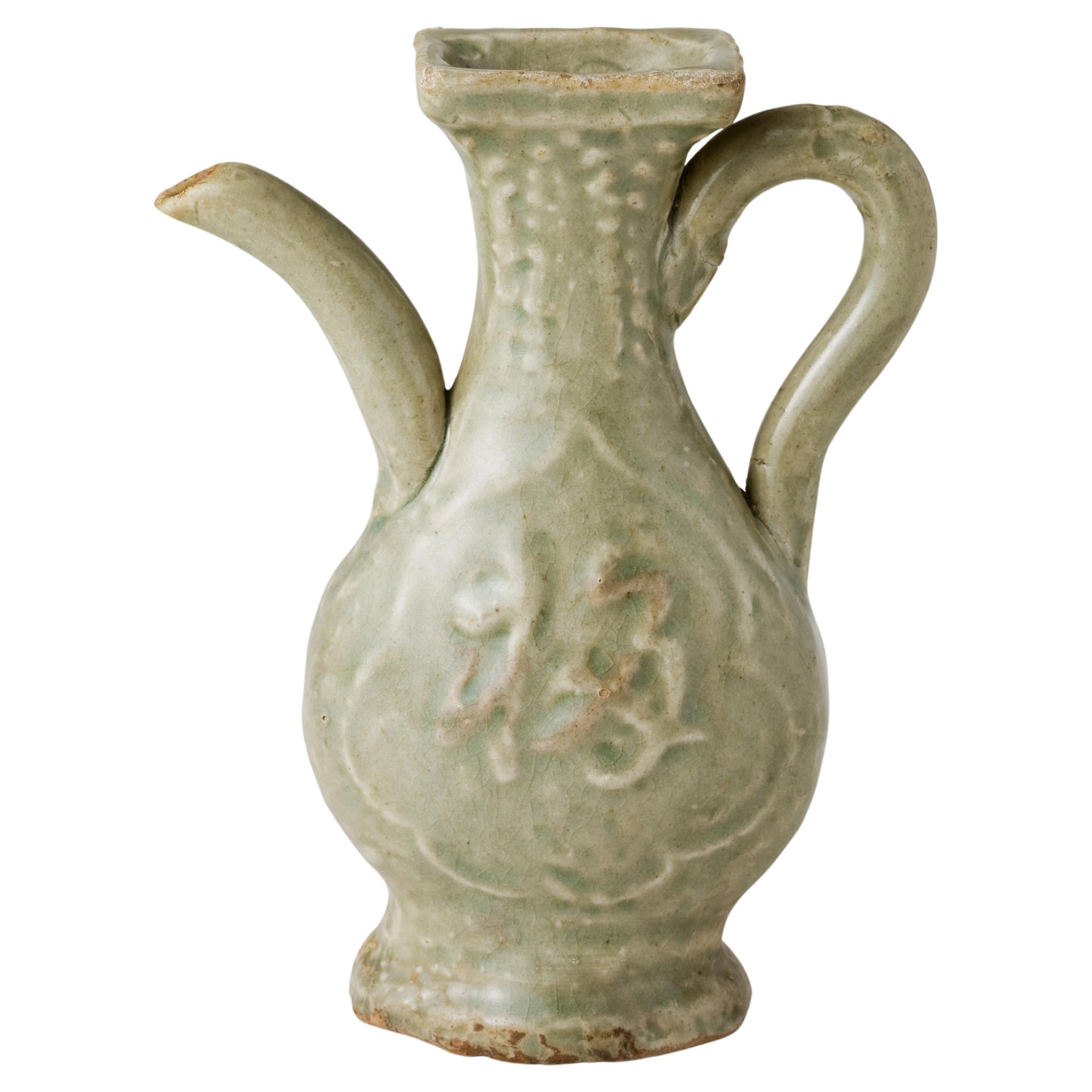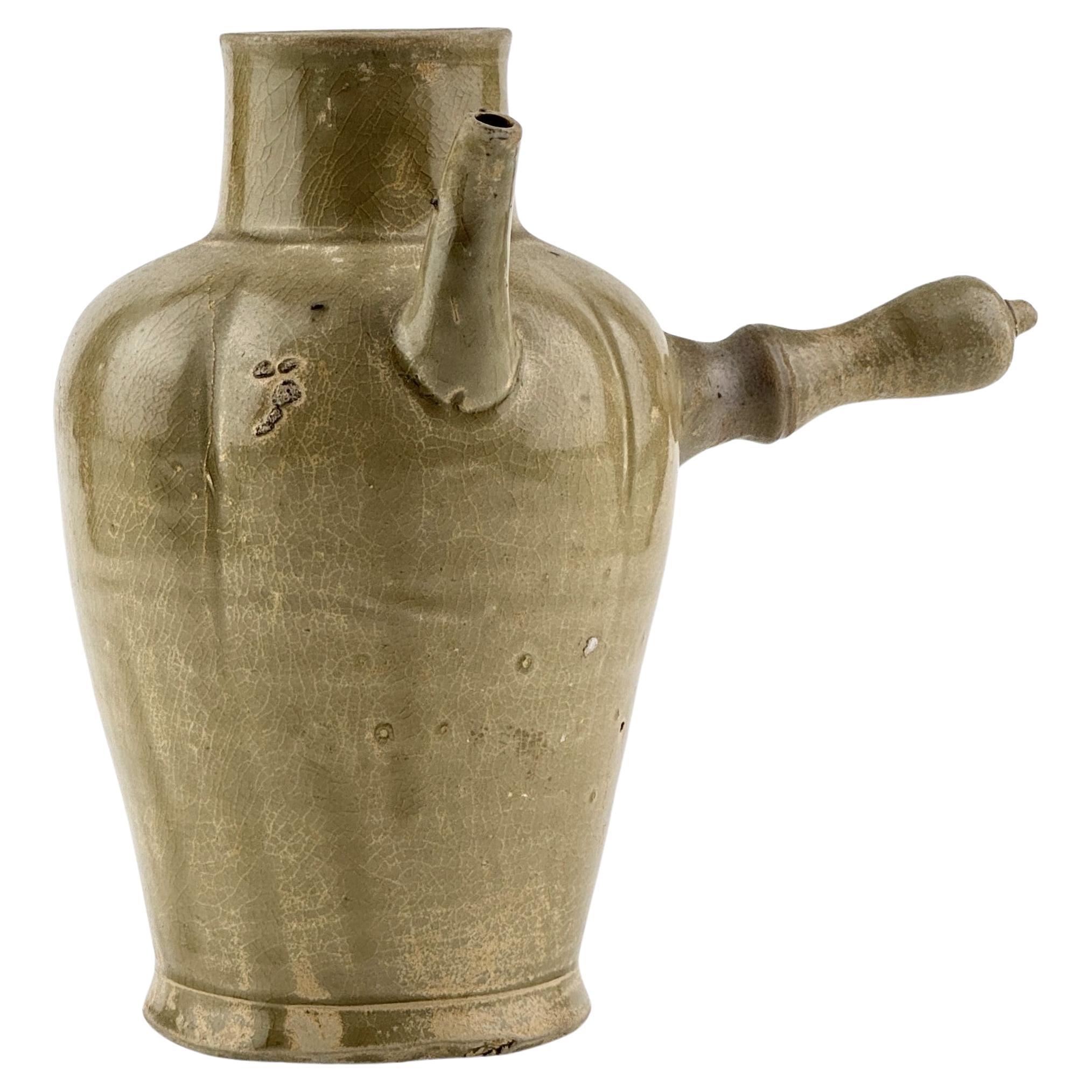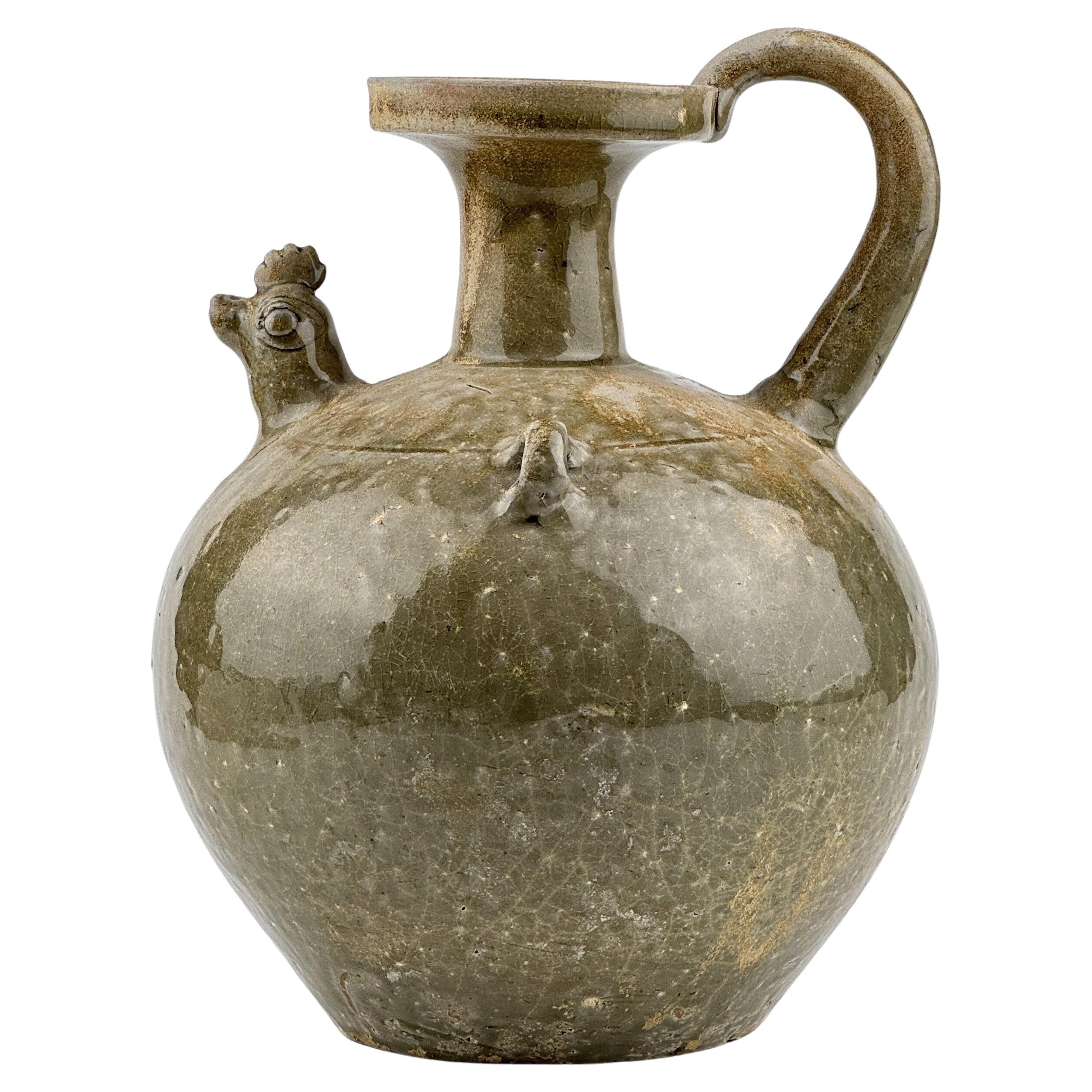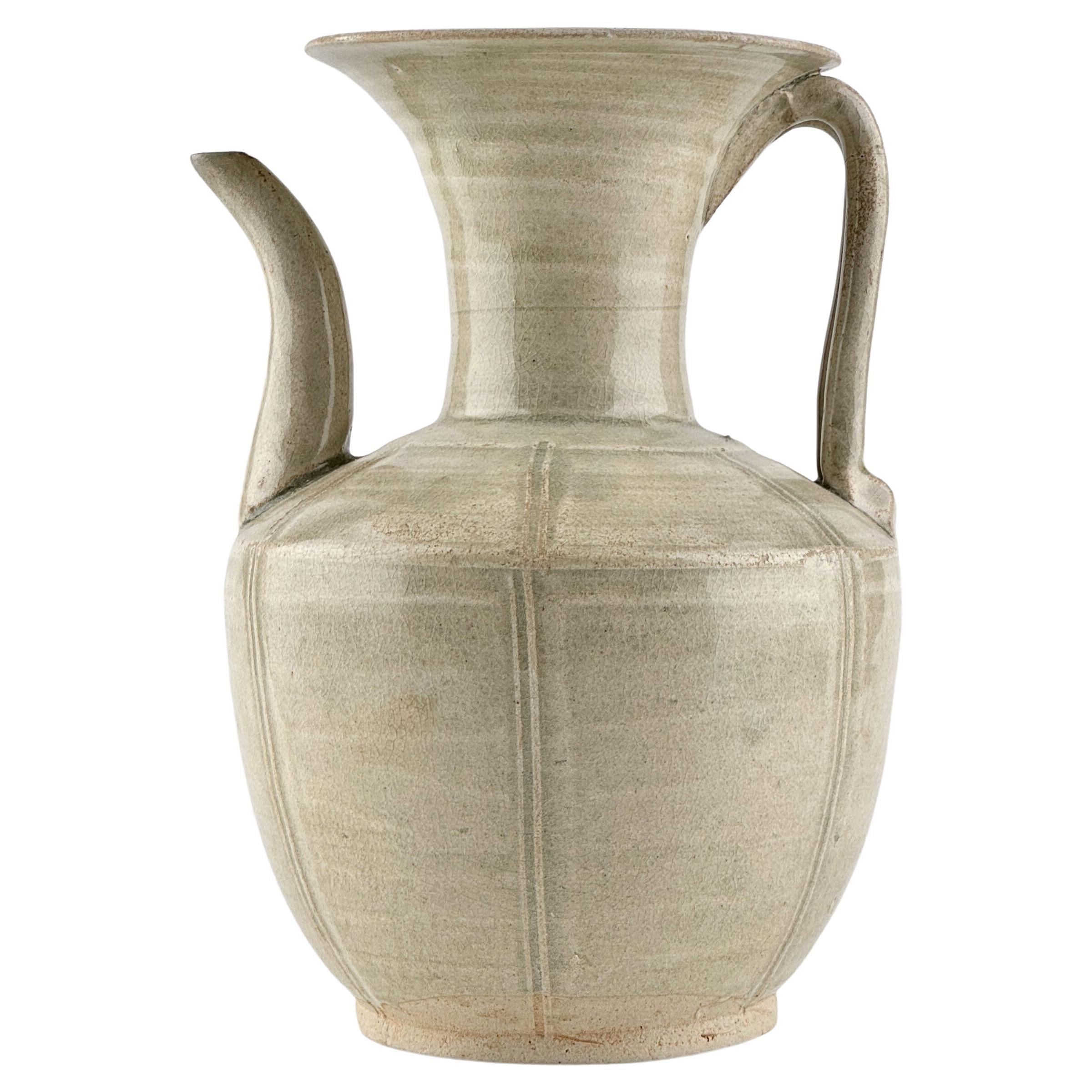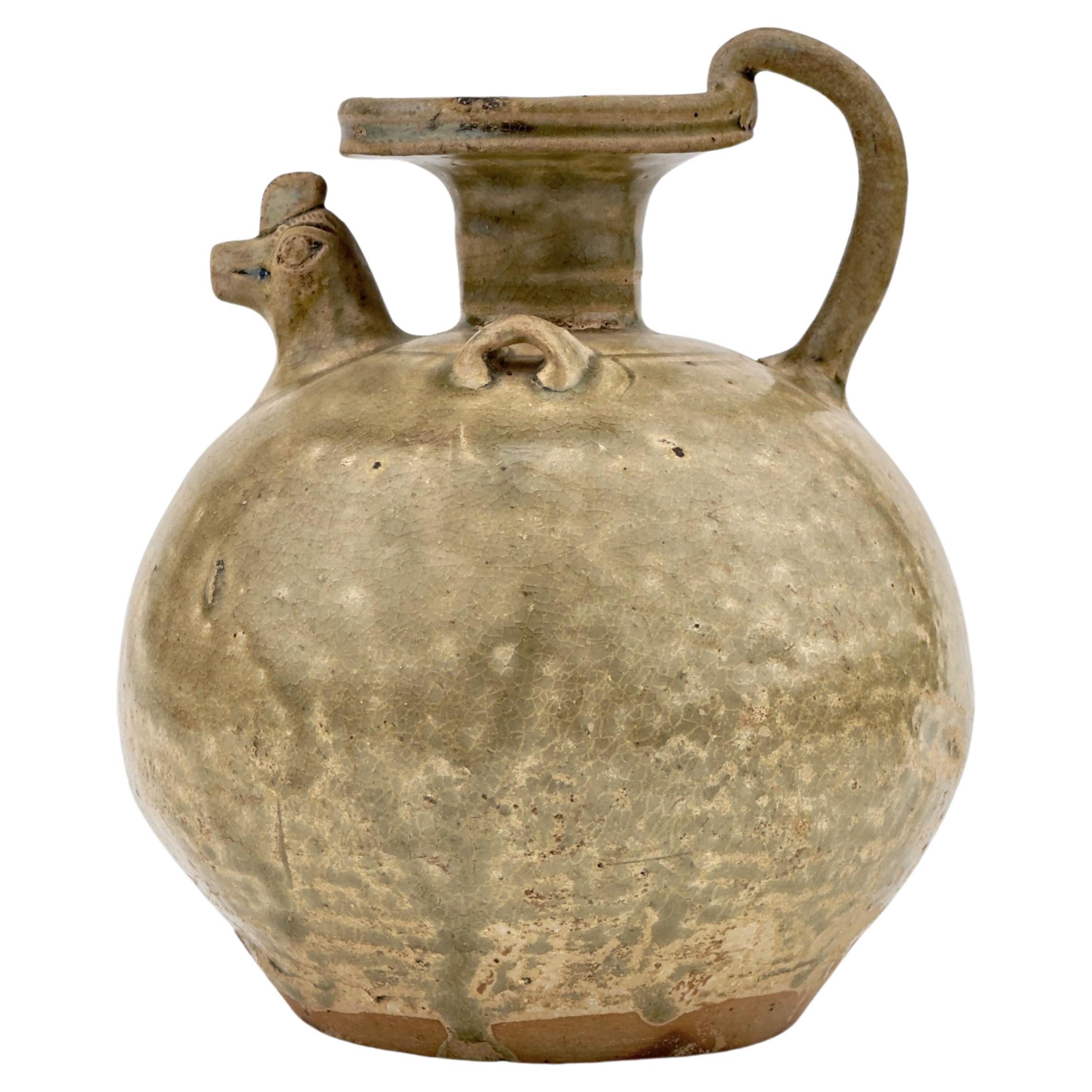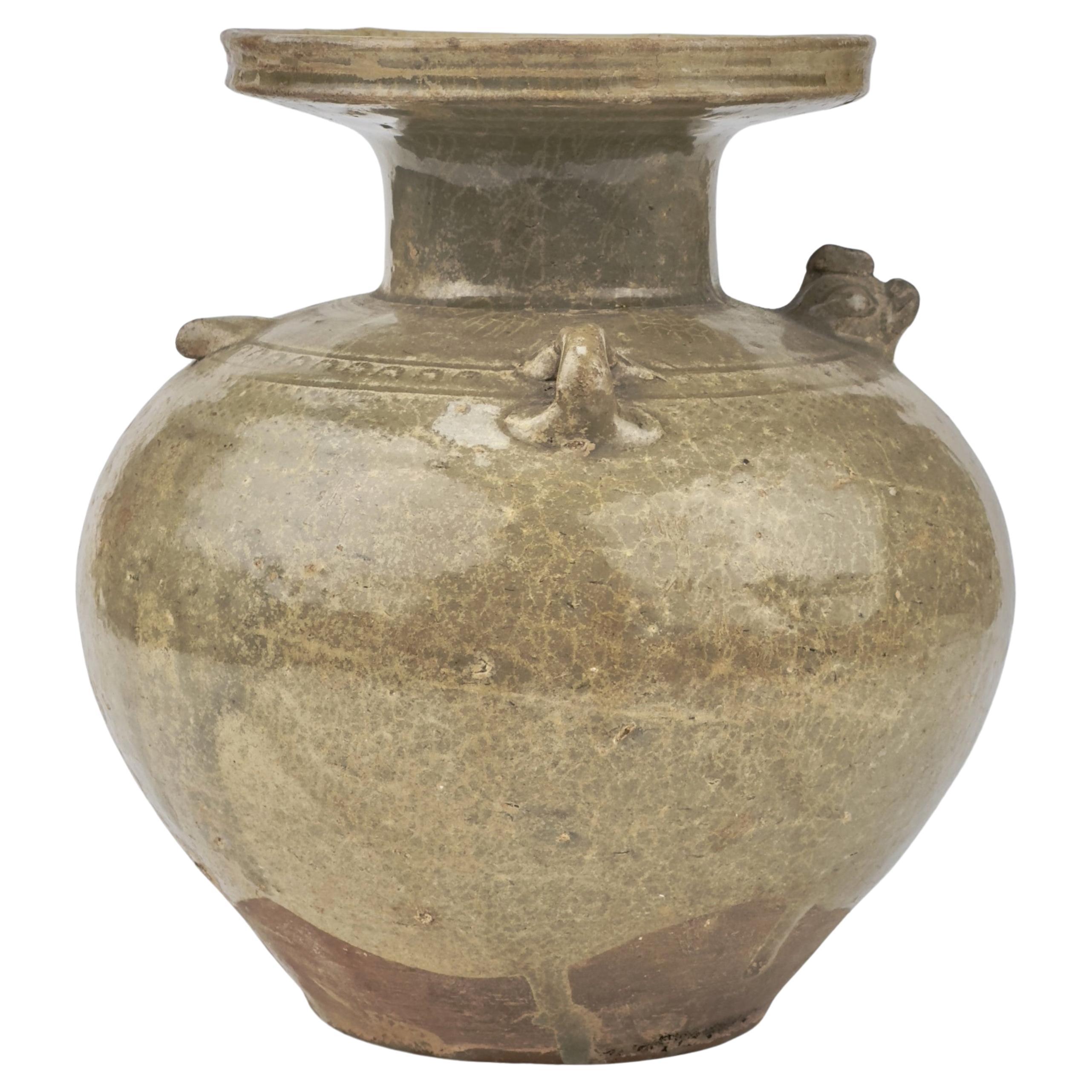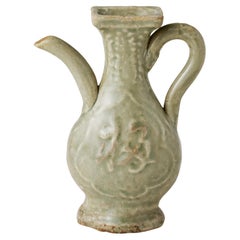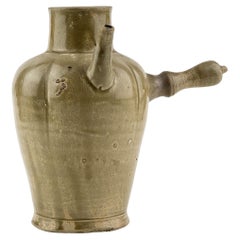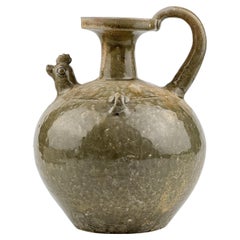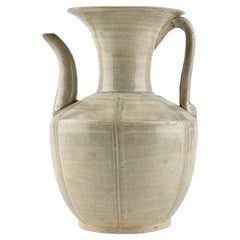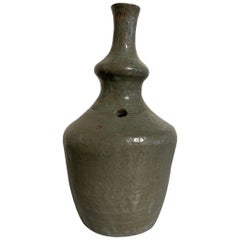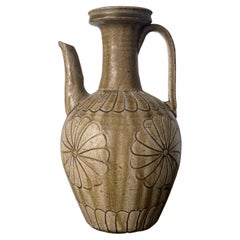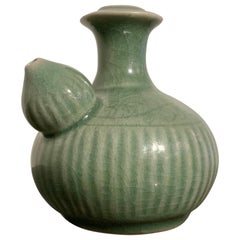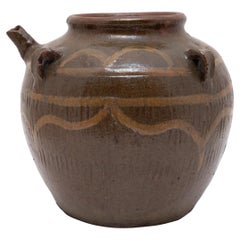Items Similar to Yue Celadon Ewer, Late Tang-Northern Song Dynasty
Want more images or videos?
Request additional images or videos from the seller
1 of 13
Yue Celadon Ewer, Late Tang-Northern Song Dynasty
$3,150
$4,50030% Off
£2,390.15
£3,414.5030% Off
€2,732.92
€3,904.1730% Off
CA$4,399.70
CA$6,285.2830% Off
A$4,891.86
A$6,988.3830% Off
CHF 2,554.26
CHF 3,648.9430% Off
MX$59,545.89
MX$85,065.5530% Off
NOK 32,591.26
NOK 46,558.9430% Off
SEK 30,536.45
SEK 43,623.5030% Off
DKK 20,396.28
DKK 29,137.5530% Off
Shipping
Retrieving quote...The 1stDibs Promise:
Authenticity Guarantee,
Money-Back Guarantee,
24-Hour Cancellation
About the Item
This Yue ware celadon ewer features a gracefully rounded body that expands smoothly, complemented by a wide, flaring mouth. The translucent olive-green glaze envelops the surface, enhancing its depth and highlighting the vertical ridges that run along the body, adding a sense of visual balance. The gently curved spout follows an organic form, while the strap handle arches elegantly, ensuring ease of use. A finely crafted floral appliqué adorns the neck, and the small perforated lugs on the shoulder suggest they may have once secured a lid.
Period : Late Tang - Northern Song Dynasty
Type : Ewer
Medium : Yue Celadon
Condition : Excellent
Provenance : Acquired in late 1990s from Hongkong
Reference
1) NSW - Accession number 2781975 - Ewer 9th century-10th century
(Type : Closely related)
2) MIA - Accession Number 991801 - Ewer, 9th century
(Type : Closely related)
* Yue Ware
Yue wares, distinguished by their dense, fine-grained grey stoneware body and thin olive-green glaze, were produced in Zhejiang province and widely exported across Asia, even reaching Egypt. The name "Yue" originates from the ancient Wu-Yue kingdom, which existed during the Warring States period and later reemerged in the Three Kingdoms era.
Developing gradually over nearly a millennium, Yue ware evolved from the Han dynasty to the early Song period. The earliest celadon-like ceramics, believed to date back to the 3rd century BCE, are considered precursors of Yue ware. While kiln sites producing Yue ware from the Han to the Six Dynasties periods have been identified, there remains a significant gap in evidence between the late 6th century and the first half of the 9th century, as no production sites from this period have yet been discovered. The most prolific and significant Yue ware kilns of the late Tang period were located around Shanglin Lake.
Among the various forms produced during the late Tang period, Yue ware ewers were particularly favored. This ewer, featuring a strap handle, vertically ribbed ovoid body, wide flaring neck, and a somewhat awkwardly curved spout, is characteristic of Yue wares from the late 9th to 10th centuries.
Unlike the funerary ceramics of the Tang dynasty, which did not influence later ceramic traditions, Yue wares played a crucial role in shaping subsequent developments in Chinese ceramics.
- Dimensions:Height: 7.29 in (18.5 cm)Diameter: 4.34 in (11 cm)
- Style:Tang (Of the Period)
- Materials and Techniques:Celadon,Glazed
- Place of Origin:
- Period:
- Date of Manufacture:Late Tang - Northern Song Dynasty
- Condition:Minor fading.
- Seller Location:seoul, KR
- Reference Number:1stDibs: LU9577243380852
About the Seller
4.8
Gold Seller
Premium sellers maintaining a 4.3+ rating and 24-hour response times
Established in 1999
1stDibs seller since 2023
38 sales on 1stDibs
Typical response time: <1 hour
- ShippingRetrieving quote...Shipping from: seoul, Korea South
- Return Policy
Authenticity Guarantee
In the unlikely event there’s an issue with an item’s authenticity, contact us within 1 year for a full refund. DetailsMoney-Back Guarantee
If your item is not as described, is damaged in transit, or does not arrive, contact us within 7 days for a full refund. Details24-Hour Cancellation
You have a 24-hour grace period in which to reconsider your purchase, with no questions asked.Vetted Professional Sellers
Our world-class sellers must adhere to strict standards for service and quality, maintaining the integrity of our listings.Price-Match Guarantee
If you find that a seller listed the same item for a lower price elsewhere, we’ll match it.Trusted Global Delivery
Our best-in-class carrier network provides specialized shipping options worldwide, including custom delivery.More From This Seller
View AllA Molded Longquan Celadon 'Fu Shou' Ewer, Ming Dynasty
Located in seoul, KR
One side of the vase showcases a panel with the Shou character at its center, symbolizing longevity, while the opposite side displays the Fu character, signifying luck. The neck of the vase is adorned with leaves. There are similar types and decoration but varying in shape, resembling a pear, all from the same era and crafted in celadon, often referred to as 'fu shou' vases.
Period: Yuan-Ming Dynasty (1271-1644)
Region: Longquan, China
Medium: Celadon
Type: Ewer
Provenance : Acquired in late 1990s from Hongkong
Reference
1) British Museum - Museum number 1931,1118.5
(Type : Closely related)
2) Christies NEW YORK 24–25 MAR 2022 - Important Chinese Ceramics and Works of Art - Lot 1105
(Price realised : 9,450 USD / Type : Related)
3) Sotheby's New York 19 March 2024 - Chinese Art - Lot 172
(Price range : 15,000 USD - 20,000 USD / Type : Related)
* Ming Dynasty Longquan Celadon
Longquan celadon from the Ming Dynasty typically exhibits a more robust and heavier stoneware body compared to its Song Dynasty predecessors. The Ming era saw an evolution in celadon glaze, achieving a wider spectrum of green hues, from olive to bluish-greens. Ming celadons...
Category
Antique 15th Century and Earlier Hong Kong Ming Antiquities
Materials
Celadon
$1,995 Sale Price
50% Off
Celadon Ewer with Straight Handle, Tang to Northern Song Dynasty
Located in seoul, KR
Celadon-glazed ewer characterized by its simple and functional design. The piece features a straight handle extending horizontally from the body and a short spout for pouring liquids...
Category
Antique 15th Century and Earlier Hong Kong Tang Antiquities
Materials
Celadon
$2,925 Sale Price
35% Off
Rare Yue Celadon Chicken-Head Ewer, Jin-Southern Dynasty
Located in seoul, KR
Chicken-head ewers are among the most distinct and emblematic pottery pieces from the Han (206 BC ~ AD 220) to the Tang dynasties. Their production commenced during the Jin dynasty i...
Category
Antique 15th Century and Earlier Hong Kong Han Antiquities
Materials
Pottery
$6,950 Sale Price
50% Off
A Zhejiang Porcelain Ewer, Northern Song Dynasty
Located in seoul, KR
The oviform body is divided into few lobes. All covered in a finely crackled pale olive-green glaze. The surface and glaze characteristics are definitive, confirming the authenticity...
Category
Antique 15th Century and Earlier Hong Kong Antiquities
Materials
Porcelain
$2,925 Sale Price
35% Off
Rare Yue Celadon Chicken-Head Ewer, Jin-Southern Dynasty
Located in seoul, KR
Chicken-head ewers are among the most distinct and emblematic pottery pieces from the Han (206 BC - AD 220) to the Tang (618-907) dynasties. Their production commenced during the Jin...
Category
Antique 15th Century and Earlier Hong Kong Han Antiquities
Materials
Celadon, Stoneware
$7,160 Sale Price
60% Off
Rare Yue Celadon Chicken-Head Ewer, Jin-Southern Dynasty
Located in seoul, KR
Chicken-head celadon is among the most distinct and emblematic piece from the dynamic yet innovative era spanning from the Han (206 BC - AD 220) to the Tang (618-907) dynasties. Thei...
Category
Antique 15th Century and Earlier Chinese Han Antiquities
Materials
Celadon
$3,495 Sale Price
50% Off
You May Also Like
Korean Celadon Glazed Ritual Ewer, Kundika, Goryeo Dynasty, 13th-14th Century
Located in Austin, TX
An understated and very heavily potted celadon glazed Korean ritual ewer or water sprinkler, kundinka, Goryeo Dynasty, 13th-14th century.
The unusu...
Category
Antique 15th Century and Earlier Korean Ceramics
Materials
Stoneware
Japanese Ko-Seto Stoneware Ewer with Carved Design
Located in Atlanta, GA
On offer is a rare Ko-seto (old seto) stoneware ewer from Kamakura period (12-14th century) Japan. The exceptionally heavily potted ewer is made of stoneware. The main body was likely hand-coiled with individually built handle, sprout and wheel-made neck and mouth assembled. It takes the basic form from the contemporary Chinese ewer...
Category
Antique 15th Century and Earlier Japanese Archaistic Ceramics
Materials
Stoneware
Small Chinese Celadon Glazed Porcelain Kendi, Qing Dynasty, 18th Century, China
Located in Austin, TX
A darling small Chinese celadon glazed kendi, or pouring vessel, mid Qing Dynasty, 18th century, China, for the Southeast Asian market.
The diminutive kendi of typical form, with ...
Category
Antique 18th Century Chinese Qing Ceramics
Materials
Porcelain
Provincial Chinese Glazed Water Jug, c. 1850
Located in Chicago, IL
This 19th-century kitchen vessel is coated inside and out with a dark brown glaze that clings to its ribbed sides with subtle color variation. Designed for serving water or tea, the squat jar features a narrow neck, small strap handles, and a short spout for pouring. The rounded shoulders are brushed with simple linework in a contrasting light brown glaze. Textured with pitted wear and other imperfections, the rustic vessel is wonderful as an unusual vase...
Category
Antique Mid-19th Century Chinese Qing Ceramics
Materials
Ceramic
Chinese Yueyao Celadon Glazed Jar 'Guan', Five Dynasties, 10th Century
Located in Austin, TX
A sublime Chinese Yueyao glazed guan jar with incised decoration and applied handles, five dynasties period (907- 979 AD), China.
The vessel of somewhat flattened globular form, w...
Category
Antique 15th Century and Earlier Chinese Tang Ceramics
Materials
Stoneware
Antique Chinese pottery green-glazed vase/[Liao Dynasty]/10th century
Located in Sammu-shi, Chiba
We are pleased to introduce a glazed ceramic vase from the Liao dynasty of China, dating from the 10th century, about 1,000 years ago.
The Liao dynasty was established by the Qidan ...
Category
Antique 15th Century and Earlier Chinese Other Vases
Materials
Pottery
